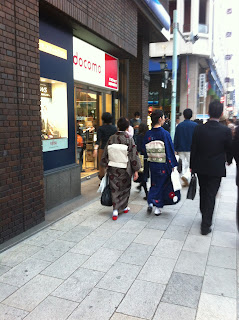This weekend our family spent some time with "Mormon Helping Hands" in Onagawa, a small coastal town in the Tohoku region of Japan, which was very hard hit by the earthquake and tsunami on March 11th. Onagawa has a population of almost 10,000, making it about as populous as Littleton. It is located in a small valley along the coast. Many lives and homes were lost that day, and hundreds of townspeople are still living in shelters.
It took about 8 hours to get there by bus from Tokyo, overnight. We stopped several times at rest stops, and tried to get some sleep on the bus!
 |
| To make your meal choice, you purchase a ticket, and give it to the people behind the counter. When your food is ready, your number is called. |
 |
| Curry rice for an early morning meal before our day in Onagawa |
As we approached Onagawa, we started seeing evidence of the tsunami and its devastation.
 |
| This house is still uninhabitable. Hundreds of people in Onogawa are living in shelters. Initial clean up has taken place, and roads have been repaved. The town has a very long way to go, though. |
|
 |
| Mr. Nanto takes a picture of a building laying on its side. |
|
 |
| The force of the tsunami waters knocked some buildings down. |
 |
This was the advertisement posted in the community in the weeks leading up to the event. "Cultural exchanges" are a popular thing in Japan. Of course, there has been a huge emphasis on "cleaning up" after the tsunami, and this time community leaders expressed the need for "cheering up." That was our goal for the day. The theme for the day was "the west" (cowboys, pioneers), but members of our group represented 10 countries in all, not just the U.S.!
|
We held our event on the grounds of this elementary school high up in the foothills, less than five minutes from where the town was devastated. We got our assignments and organized ourselves to provide a "cultural exchange" day of games, food, and music for a group of school children, some of their parents, and some senior citizens from the community.
 |
| In Japan, for any event at all, there is an "opening ceremony." Here, the mayor of the town is showing us aerial before-and-after pictures of the town. He explained that nearly 900 townspeople lost their lives in the tsunami, and countless homes and businesses were destroyed, but that Onagawa is still a beautiful place blessed by the ocean and mountains. |
|
|
|
|
|
|
|
|
|
|
|
|
|
|
|
|
|
|
|
|
|
|
|
|
|
|
|
Next, groups were formed combining teenagers from our group with the Japanese school children. The adults set up 10 games (field day style!) and cooked the food. Each group had a different color bandana. It is very important for Japanese people to feel part of a group, and for groups to be very clearly identified.
 |
| Tommy (orange group!) making introductions |
|
 |
| Kaela and Nanako (blue group!) were side by side most of the day:) |
|
 |
| Spoon relay (with cotton balls instead of eggs!). Waters from the tsunami had reached within 1 meter of the fence in the background of this photo (beyond the fence, there is a steep slope down). Luckily this school was built on high ground. Townspeople never imagined a tsunami could bring water this high into the hills. |
 |
| "Field Day" style games |
|
 |
| During our "western" style lunch (sloppy joes!), we talked with the Sugiura family. Mr. Sugiura is a fire fighter in town, and they lived 1 minute from the ocean. Their story of surviving the tsunami is amazing. Mr. Nanto blogged about it in detail here. |
|
In late afternoon, we boarded our buses and headed back to Tokyo. This was an unforgettable 24 hours for our family.




























































